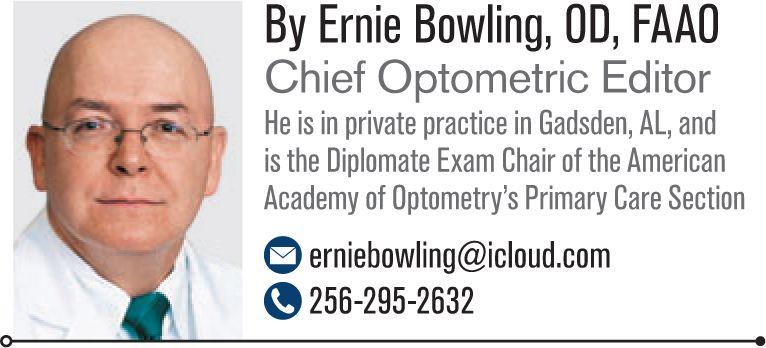UPP: A good decision for our patients
Since 2013, one by one, the four major contact lens manufacturers (Johnson & Johnson, Alcon, Bausch + Lomb, and CooperVision) have enacted pricing policies that seek to limit what contact lens discounters can charge for certain products.

Since 2013, one by one, the four major contact lens manufacturers (Johnson & Johnson, Alcon, Bausch + Lomb, and CooperVision) have enacted pricing policies that seek to limit what contact lens discounters can charge for certain products. This unilateral pricing policy (UPP) dictates the minimum price that can be charged for contact lenses. Because the policy is unilateral, the manufacturers enacted it without agreement from any reseller. As a means of enforcement, manufacturers can discontinue selling their products to eyecare professionals, retail outlets, or online retailers found advertising or selling lenses for less than the mandated price.
Related: AOA fights back against 1-800 CONTACTS-backed state legislation
The response to these UPPs fell into two camps. Practitioners were overjoyed-UPP instantly created a perfectly level playing field, eliminating the volume discounts for online retailers.
Opponents, including big discounters like Costco and 1-800 CONTACTS, say the policies amount to illegal price-fixing and are restricting consumer choice. They are now lobbying state legislatures around the country in an effort to outlaw the practice, and Utah, the home of 1-800 CONTACTS, has approved legislation that would negate UPP.
On March 27, Utah signed into law the Contact Lens Consumer Protection Act, making the state the first to ban UPP.1 Now, Alcon, Bausch + Lomb, and Johnson & Johnson Vision Care have all filed a lawsuit to stop Utah Attorney General Sean Reyes from enforcing the law.2
Similiar anti-UPP bills are in the works in 14 other states.3 In March, Costco sued Johnson & Johnson for what it says are antitrust violations, and a consumer class-action has also been filed.4 Yet the complaints from the mass merchandisers may be hollow. Laura Angelini, president of Johnson & Johnson Vision Care, stated the company was “very pleased to see that initial pricing data is showing that 58 percent of consumers have realized a price reduction on Acuvue brand contact lenses since our UPP was implemented.”5
Next: Patient education
The concern for big online retailers is profit, pure and simple. And their record here speaks for itself. We are all too familiar with the passive verification tactics these companies use to fulfill orders. Yet for optometrists and other healthcare providers, the concern is patient care and safety. Contact lenses are a medical device, not a commodity-a point not to be forgotten in the noise of the discussion.
More from Dr. Bowling: Struggling law schools-are OD schools next?
As it is with most problems in our profession, it's a matter of patient education. We need to educate our patients that it is not just a piece of plastic going into their eye. We, as eyecare professionals, are the ones legally responsible for their ocular health and wellbeing.
We have the knowledge, the training, experience, and equipment to make the best clinical decision. Our professional knowledge provides value. A lot of thought goes into a contact lens fit. It's not just slapping on a lens and sending the patient out the door.
Free of cost considerations, the patient and doctor can make decisions based solely on the information provided by the patient to his eye doctor regarding his ocular health needs, visual needs, and what contact lens best fits those requirements, irrespective of cost.
I think contact lenses give us another opportunity to demonstrate to our patients our knowledge and abilities, and how much we care-our value, if you will. I'm glad that cost doesn't have to enter in to that discussion, thanks to UPP. Now, the decision is about quality of care and clinical need. After all, we are talking about eyes; we're given only two, and they have to last a lifetime. Our precious gift of sight isn't a commodity and shouldn't be treated as one.
References:
1.Utah leads nation as first state to ban “UPP” price fixing schemes in contact lens industry. Prnewswire.com. Available at: www.prnewswire.com. Accessed 4/7/2015.
2. Harvey T. Contact lens makers suing Utah attorney general to stop enforcement of new law.The Salt Lake Tribune. April 15, 2015. Available at: http://www.sltrib.com/news/2400816-155/contact-lens-makers-suing-utah-attorney. Accessed: 5/17/2015.
3. McCarthy C. AOA fights back against 1-800 CONTACTS-backed state legislation. Optometry Times. February 13, 2015. Available at: http://optometrytimes.modernmedicine.com/optometrytimes/news/aoa-fights-back-against-1-800-contacts-backed-state-legislation. Accessed: 3/24/15.
4. Thomas K. Contact lens makers and discounters tussle over price setting. New York Times. March 26, 2015. Available at: http://www.nytimes.com/2015/03/27/business/contact-lens-makers-and-discounters-tussle-over-price-setting.html. Accessed: 3/27/15.
5. Angelini L. A message to Acuvue brand customers and new wearers in the United States. Available at: http://jnjvisioncareinfo.com/?utm_source=APCO&utm_medium=cpc&utm_campaign=VisionCare. Accessed 3/28/14.
Newsletter
Want more insights like this? Subscribe to Optometry Times and get clinical pearls and practice tips delivered straight to your inbox.